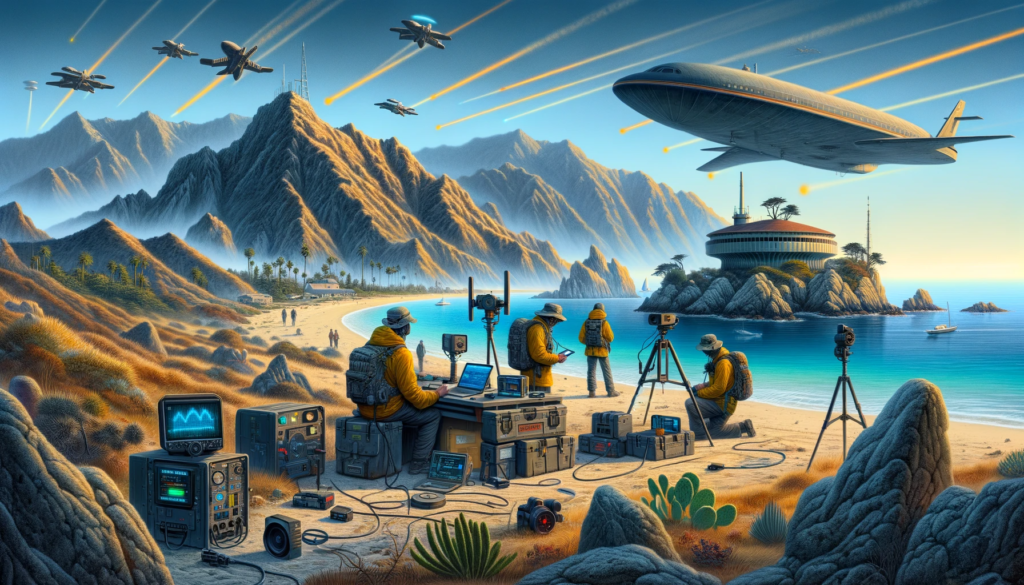Scientific Exploration of Unidentified Anomalous Phenomena: Insights and Ambiguities from UAPx’s Catalina Island Expedition

“Initial Results From the First Field Expedition of UAPx to Study Unidentified Anomalous Phenomena” was published on December 1, 2023. The authors, with their diverse backgrounds ranging from academic research in physics to technical, engineering, media, and UAP-specific research, bring a multifaceted perspective to the study of Unidentified Anomalous Phenomena.
The UAPx expedition took place over a week-long period, from July 10 to 17, 2021. The UAPx expedition took place at two primary locations: a flat rooftop in Laguna Beach, California, and another site in Avalon on Catalina Island. Additionally, a mobile viewpoint was provided by the O.S.I.R.I.S. vehicle.
The choice of these locations, particularly Catalina Island, was due to its status as a purported UAP hotspot prior to the notable Nimitz carrier strike group UAP encounter in 2004. The timing of the expedition was chosen to reduce the probability of encountering a fully cloudy week, which suggests that clear visibility and unobstructed observation conditions were crucial for their research objectives.
A documentary was made about the UAPx expedition, titled “A Tear in the Sky”. The documentary was produced by Omnium Media and directed by Caroline Cory. It features various events and findings from the UAPx expedition, focusing on the study of Unidentified Aerial Phenomena (UAP)
The authors of the report and their affiliations are as follows:
- M. Szydagis: Affiliated with the Department of Physics at the University at Albany, State University of New York (SUNY), Albany, NY, USA. This affiliation suggests a background in physics and possibly academic research.
- K. H. Knuth: Also associated with the Department of Physics at the University at Albany, SUNY, Albany, NY. Like Szydagis, Knuth has expertise in physics and academic research.
- B. W. Kugielsky: Affiliated with TekSynap, a company based in Reston, VA, USA. TekSynap provides technology solutions and services, indicating that Kugielsky’s expertise may lie in the technical or engineering aspects relevant to the study.
- C. Levy: Associated with UAPx, based in Lake Panasoffkee, FL, USA. UAPx is a non-profit organization focusing on the collection and scientific analysis of data on Unidentified Anomalous Phenomena. Levy’s role likely involves research or operational aspects of UAPx’s activities.
- J. D. McGowan: Also affiliated with TekSynap, Reston, VA, USA, and likely has a background similar to that of Kugielsky, involving technical or engineering expertise.
- M. D. Phelan: Associated with iHeartMedia in New York, NY, USA. iHeartMedia is a mass media company, suggesting that Phelan’s expertise might be in media, communication, or related fields.
- G. P. Voorhis Jr.: Another member affiliated with UAPx in Lake Panasoffkee, FL, USA, and likely involved in the research or operational activities related to the study of UAPs.
The significance of this report lies in its scientific approach to studying Unidentified Anomalous Phenomena (UAPs), previously known as UFOs. UAPs have gained increased attention from entities like the U.S. Department of Defense, the Navy, and NASA, and this report contributes to the more formalized and scientific examination of these phenomena.
UAPx is a non-profit organization co-founded by Naval veterans Gary Voorhis and Kevin Day involved in the notable 2004 Nimitz carrier strike group UAP encounter. Their aim is to collect and scientifically analyze new data on UAP, distinct from reanalyzing historical cases. The team’s approach emphasizes data quality, chain of custody, data provenance, and rigorous data analysis, aligning with scientific standards.
The objectives of UAPx include identifying and classifying presently unidentified, unknown, and unclassified phenomena. They aim to fill gaps in scientific knowledge about UAP due to a lack of high-quality, unclassified data, and to make their data and analysis results publicly available following peer-reviewed publications.
Methodologically, the UAPx team used various sensing devices to capture different data types, including deploying multiple cameras and sensors for robust data collection and analysis. They focused on capturing the same phenomenon from different angles for accurate estimations of size, speed, and acceleration. Additionally, they utilized AI/ML for classification purposes.
Instrumentation included visible light and near-IR imagery, IR videography, and radiation detection. They used the UFODAP system for visible/near-IR imagery, FLIR ThermaCam units for IR videography, and the Cosmic Watch developed by MIT for radiation detection. These tools allowed for the capture of various data types and the identification of potential anomalies.
One significant observation was a dark spot captured by the UFODAP system, which remained an unresolved ambiguity. This particular observation, occurring around 4 am on July 16, involved a dark spot in the visible/near-IR camera possibly coincident with ionizing radiation, which resisted a prosaic explanation.
The expedition successfully collected a significant amount of data, including approximately one hour of triggered visible/night-vision-mode video, over 600 hours of untriggered infrared video, and 55 hours of background radiation measurements. This extensive data collection is valuable for the scientific study of UAPs.
In summary, this report marks a significant effort in applying rigorous scientific methods to the study of UAPs. The multi-disciplinary approach, use of diverse instrumentation, and commitment to thorough data analysis make this a notable contribution to the field.


